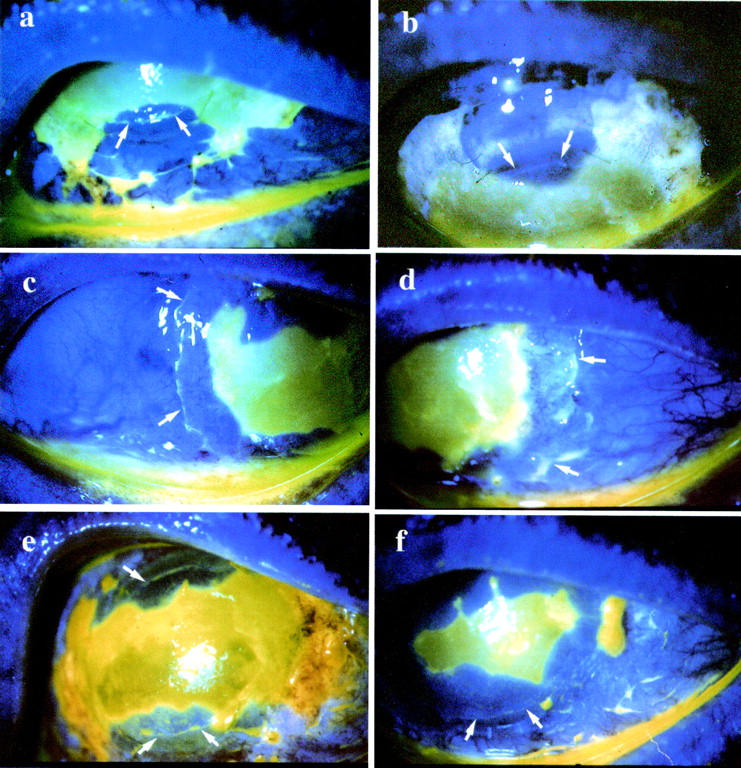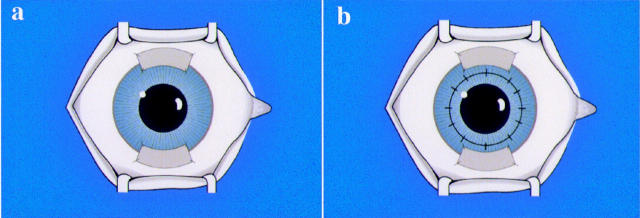Abstract
AIM—To describe a surgical technique for autologous limbal stem cell transplantation and the outcome of a series of patients with unilateral stem cell deficiency. METHODS—A report of six consecutive patients who underwent autologous limbal stem cell transplantation is presented. The primary diagnosis included alkali burn (n=3), conjunctival intraepithelial neoplasia (CIN) (n=1), recurrent pterygium (n=1), and contact lens induced keratopathy (n=1). The autologous transplanted tissue consisted of peripheral cornea, limbus, and conjunctiva obtained from the contralateral eye. Three of the above patients underwent penetrating keratoplasty in association with auto-limbal transplantation. A significant modification to established techniques was the close monitoring of conjunctival epithelial migration in the immediate postoperative period. If conjunctival epithelium threatened to migrate on to the corneal surface, it was mechanically removed at the slit lamp and prevented from crossing the limbus. This was required in three patients. RESULTS—The mean follow up was 18.8 months. The outcome was satisfactory in all cases: a stable corneal surface was restored and there was a substantial improvement in vision and symptoms. One patient had a primary failure of the corneal allograft associated with glaucoma, and 6 months later developed a retinal detachment. No complications were noted in the donor eye with the exception of one patient who developed filamentary keratitis along the edge of the donor site. CONCLUSION—Autologous limbal transplantation with corneal, limbal, and conjunctival carriers was found to be useful for ocular surface reconstruction, over a mid-term follow up, in patients with unilateral stem cell deficiency. Close monitoring of the migration of conjunctival epithelium in the immediate postoperative period, and preventing it from crossing the limbus, ensured that the corneal surface was re-epithelialised exclusively from epithelial cells derived from the transplanted limbal tissue. This approach should improve the success of this procedure.
Full Text
The Full Text of this article is available as a PDF (198.2 KB).
Figure 1 .
(a) Diagram illustrating the placement of auto-limbal explants at the 6 and 12 o'clock positions of recipient eye. (b) Auto-limbal transplant with corneal graft. The graft is usually 7 mm in size as the peripheral 2 mm, both above and below, is covered by the explants.
Figure 2 .

Fluorescein stained ocular surface photographs of recipient eye that had undergone auto-limbal transplantation. On day 2 following surgery, donor epithelial cells can be seen migrating on to the recipient surface from the explants placed at the 6 o'clock (a) and 12 o'clock (b) positions. Arrows indicate the anterior edge of the explants. On day 4 following surgery, host conjunctival epithelial cells can be seen migrating from the edge (arrows) of the recessed conjunctiva on both the temporal (c) and nasal (d) sides. The advancing conjunctival epithelial sheets were mechanically debrided with a surgical blade (e), leaving behind the limbal explant derived expanding corneal epithelial cells (arrows). (f) The circumferentially migrating limbal explant derived corneal epithelial cells have met temporally and nasally. The large corneal epithelial defect healed with corneal cells and the small nasal conjunctival defect healed with conjunctival cells. Healing was complete by day 8.
Figure 3 .

(a) Preoperative photograph of the eye of a patient with alkali burn and a large persistent corneal epithelial defect. (b) Intraoperative photograph showing recessed conjunctiva and removal of fibrovascular tissue from the corneal surface. (c) After removal of fibrovascular tissue, the underlying corneal stroma is found to be clear and transparent. (d) Intraoperative photograph showing auto-limbal explants sutured in place at the 6 and 12 o'clock positions. (e) Postoperative photograph after corneal epithelial healing was complete (taken 1 month after surgery).
Selected References
These references are in PubMed. This may not be the complete list of references from this article.
- Chen J. J., Tseng S. C. Abnormal corneal epithelial wound healing in partial-thickness removal of limbal epithelium. Invest Ophthalmol Vis Sci. 1991 Jul;32(8):2219–2233. [PubMed] [Google Scholar]
- Chen J. J., Tseng S. C. Corneal epithelial wound healing in partial limbal deficiency. Invest Ophthalmol Vis Sci. 1990 Jul;31(7):1301–1314. [PubMed] [Google Scholar]
- Clinch T. E., Goins K. M., Cobo L. M. Treatment of contact lens-related ocular surface disorders with autologous conjunctival transplantation. Ophthalmology. 1992 Apr;99(4):634–638. doi: 10.1016/s0161-6420(92)31925-6. [DOI] [PubMed] [Google Scholar]
- Copeland R. A., Jr, Char D. H. Limbal autograft reconstruction after conjunctival squamous cell carcinoma. Am J Ophthalmol. 1990 Oct 15;110(4):412–415. doi: 10.1016/s0002-9394(14)77023-0. [DOI] [PubMed] [Google Scholar]
- Dua H. S., Azuara-Blanco A. Allo-limbal transplantation in patients with limbal stem cell deficiency. Br J Ophthalmol. 1999 Apr;83(4):414–419. doi: 10.1136/bjo.83.4.414. [DOI] [PMC free article] [PubMed] [Google Scholar]
- Dua H. S., Forrester J. V. The corneoscleral limbus in human corneal epithelial wound healing. Am J Ophthalmol. 1990 Dec 15;110(6):646–656. doi: 10.1016/s0002-9394(14)77062-x. [DOI] [PubMed] [Google Scholar]
- Dua H. S., Gomes J. A., Singh A. Corneal epithelial wound healing. Br J Ophthalmol. 1994 May;78(5):401–408. doi: 10.1136/bjo.78.5.401. [DOI] [PMC free article] [PubMed] [Google Scholar]
- Dua H. S. The conjunctiva in corneal epithelial wound healing. Br J Ophthalmol. 1998 Dec;82(12):1407–1411. doi: 10.1136/bjo.82.12.1407. [DOI] [PMC free article] [PubMed] [Google Scholar]
- Harris T. M., Berry E. R., Pakurar A. S., Sheppard L. B. Biochemical transformation of bulbar conjunctiva into corneal epithelium: an electrophoretic analysis. Exp Eye Res. 1985 Nov;41(5):597–605. doi: 10.1016/0014-4835(85)90032-6. [DOI] [PubMed] [Google Scholar]
- Hayasaka S., Noda S., Yamamoto Y., Setogawa T. Postoperative instillation of low-dose mitomycin C in the treatment of primary pterygium. Am J Ophthalmol. 1988 Dec 15;106(6):715–718. doi: 10.1016/0002-9394(88)90706-4. [DOI] [PubMed] [Google Scholar]
- Herman W. K., Doughman D. J., Lindstrom R. L. Conjunctival autograft transplantation for unilateral ocular surface diseases. Ophthalmology. 1983 Sep;90(9):1121–1126. doi: 10.1016/s0161-6420(83)80056-6. [DOI] [PubMed] [Google Scholar]
- Huang A. J., Tseng S. C. Corneal epithelial wound healing in the absence of limbal epithelium. Invest Ophthalmol Vis Sci. 1991 Jan;32(1):96–105. [PubMed] [Google Scholar]
- Jenkins C., Tuft S., Liu C., Buckley R. Limbal transplantation in the management of chronic contact-lens-associated epitheliopathy. Eye (Lond) 1993;7(Pt 5):629–633. doi: 10.1038/eye.1993.145. [DOI] [PubMed] [Google Scholar]
- Kenyon K. R., Tseng S. C. Limbal autograft transplantation for ocular surface disorders. Ophthalmology. 1989 May;96(5):709–723. doi: 10.1016/s0161-6420(89)32833-8. [DOI] [PubMed] [Google Scholar]
- Kinoshita S., Kiorpes T. C., Friend J., Thoft R. A. Limbal epithelium in ocular surface wound healing. Invest Ophthalmol Vis Sci. 1982 Jul;23(1):73–80. [PubMed] [Google Scholar]
- Kruse F. E. Stem cells and corneal epithelial regeneration. Eye (Lond) 1994;8(Pt 2):170–183. doi: 10.1038/eye.1994.42. [DOI] [PubMed] [Google Scholar]
- Lindberg K., Brown M. E., Chaves H. V., Kenyon K. R., Rheinwald J. G. In vitro propagation of human ocular surface epithelial cells for transplantation. Invest Ophthalmol Vis Sci. 1993 Aug;34(9):2672–2679. [PubMed] [Google Scholar]
- Mastropasqua L., Carpineto P., Ciancaglini M., Enrico Gallenga P. Long term results of intraoperative mitomycin C in the treatment of recurrent pterygium. Br J Ophthalmol. 1996 Apr;80(4):288–291. doi: 10.1136/bjo.80.4.288. [DOI] [PMC free article] [PubMed] [Google Scholar]
- Morgan S., Murray A. Limbal autotransplantation in the acute and chronic phases of severe chemical injuries. Eye (Lond) 1996;10(Pt 3):349–354. doi: 10.1038/eye.1996.72. [DOI] [PubMed] [Google Scholar]
- Pfister R. R. Corneal stem cell disease: concepts, categorization, and treatment by auto- and homotransplantation of limbal stem cells. CLAO J. 1994 Jan;20(1):64–72. [PubMed] [Google Scholar]
- Prabhasawat P., Tseng S. C. Impression cytology study of epithelial phenotype of ocular surface reconstructed by preserved human amniotic membrane. Arch Ophthalmol. 1997 Nov;115(11):1360–1367. doi: 10.1001/archopht.1997.01100160530001. [DOI] [PubMed] [Google Scholar]
- Rubsamen P. E., Irvin W. D., McCuen B. W., 2nd, Smiddy W. E., Bowman C. B. Primary intraocular lens implantation in the setting of penetrating ocular trauma. Ophthalmology. 1995 Jan;102(1):101–107. doi: 10.1016/s0161-6420(95)31073-1. [DOI] [PubMed] [Google Scholar]
- Shimazaki J., Shinozaki N., Tsubota K. Transplantation of amniotic membrane and limbal autograft for patients with recurrent pterygium associated with symblepharon. Br J Ophthalmol. 1998 Mar;82(3):235–240. doi: 10.1136/bjo.82.3.235. [DOI] [PMC free article] [PubMed] [Google Scholar]
- Tan D. T., Ficker L. A., Buckley R. J. Limbal transplantation. Ophthalmology. 1996 Jan;103(1):29–36. doi: 10.1016/s0161-6420(96)30737-9. [DOI] [PubMed] [Google Scholar]
- Thoft R. A. Conjunctival transplantation. Arch Ophthalmol. 1977 Aug;95(8):1425–1427. doi: 10.1001/archopht.1977.04450080135017. [DOI] [PubMed] [Google Scholar]
- Thoft R. A. Keratoepithelioplasty. Am J Ophthalmol. 1984 Jan;97(1):1–6. doi: 10.1016/0002-9394(84)90438-0. [DOI] [PubMed] [Google Scholar]
- Tsai R. J., Tseng S. C. Human allograft limbal transplantation for corneal surface reconstruction. Cornea. 1994 Sep;13(5):389–400. doi: 10.1097/00003226-199409000-00003. [DOI] [PubMed] [Google Scholar]
- Tsubota K., Toda I., Saito H., Shinozaki N., Shimazaki J. Reconstruction of the corneal epithelium by limbal allograft transplantation for severe ocular surface disorders. Ophthalmology. 1995 Oct;102(10):1486–1496. doi: 10.1016/s0161-6420(95)30841-x. [DOI] [PubMed] [Google Scholar]
- Turgeon P. W., Nauheim R. C., Roat M. I., Stopak S. S., Thoft R. A. Indications for keratoepithelioplasty. Arch Ophthalmol. 1990 Feb;108(2):233–236. doi: 10.1001/archopht.1990.01070040085036. [DOI] [PubMed] [Google Scholar]
- Vastine D. W., Stewart W. B., Schwab I. R. Reconstruction of the periocular mucous membrane by autologous conjunctival transplantation. Ophthalmology. 1982 Sep;89(9):1072–1081. doi: 10.1016/s0161-6420(82)34681-3. [DOI] [PubMed] [Google Scholar]



